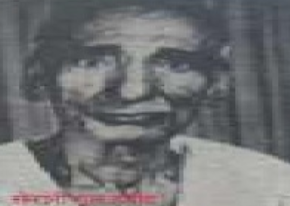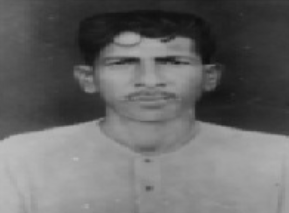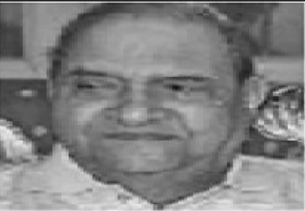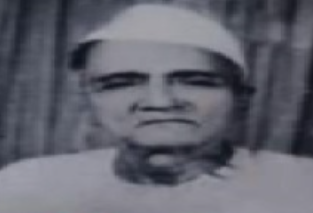People and Personalities of Mahasamund District
People and Personalities of Mahasamund District
The big stories often make the headlines of our historical narratives, but history is not only about the landmark events - it finds shape and character in the myriad events that led up to a flashpoint of change. An attempt to discover and document stories of people, events, and places linked to the freedom struggle of India at the micro level of the district has led to the creation of a Digital District Repository. Stories in this section can be broadly classified under - People & Personalities.
Raghuvar Singh
 Raghuvar Singh was born in 1897 in Tamora village, surrounded by the Baghnai river in the west of Pargana Khallari.
Raghuvar Singh was born in 1897 in Tamora village, surrounded by the Baghnai river in the west of Pargana Khallari.
Singh’s participation in the All India Conference in Jabalpur in 1930, under the leadership of Netaji Subhas Chandra Bose, marked a turning point in his involvement in the national movement. In 1922, in Chhattisgarh, particularly among the tribals who heavily relied on forest resources, the government enacted laws that violated their rights. The Kandel Satyagraha and the All India Conference created public awareness and a strong protest against this exploitation. Raghuvar also protested against repressive forest laws in the Tamora area. He proposed Tamora as the picket site, as none of the landlords were initially willing. Satyagraha plans were made for Tamora and Labhra. The Jungle Satyagraha commenced in 1930, starting from Mahasamund. Disregarding the ranger's warnings, a crowd marched from Tamora village into the forest, resulting in numerous arrests. Satyagrahis continued to defy the rules by cutting grass from the forest every day. The government made efforts to suppress the movement, imposing Section 144 around Tamora and making many arrests. On the fourth day, a gathering of ten thousand people materialized. The police deployed a force armed with 100 guns to prevent entry into the forest. During this movement, hundreds of people, including Raghuvar Singh, were arrested. They faced a trial and in October 1930, were convicted and sentenced to three months and fifteen days of imprisonment in the Central Jail, Raipur. This Satyagraha gained nationwide attention and discussion.
Raghuvar Singh passed away in 1954.
Gul Hameed
 Gul Hameed, a freedom fighter, was born in 1905 in the village of Belsonda in the Mahasamund district, at his father Abdullah's house. Since her student days, he had a growing sense of patriotism and opposition to British rule. He was deeply influenced by the ideas of Frontier Gandhi Khan Abdul Ghaffar Khan and had a special interest in listening to his articles and speeches. Despite his parent's protests, Gul Hameed remained unwavering in his commitment to the freedom movement. Eventually, his father decided to interrupt his studies and sent him to his aunt's house in Rawalpindi, which is present-day Pakistan. Even there, he lacked interest in his studies and wholeheartedly immersed himself in the freedom movement.
Gul Hameed, a freedom fighter, was born in 1905 in the village of Belsonda in the Mahasamund district, at his father Abdullah's house. Since her student days, he had a growing sense of patriotism and opposition to British rule. He was deeply influenced by the ideas of Frontier Gandhi Khan Abdul Ghaffar Khan and had a special interest in listening to his articles and speeches. Despite his parent's protests, Gul Hameed remained unwavering in his commitment to the freedom movement. Eventually, his father decided to interrupt his studies and sent him to his aunt's house in Rawalpindi, which is present-day Pakistan. Even there, he lacked interest in his studies and wholeheartedly immersed himself in the freedom movement.
In 1931-32, while participating in a procession and chanting slogans, Gul Hameed was arrested by the police at Taga station and sentenced to 15 days in Raipur Jail. After Rawalpindi, he was sent to his maternal uncle's house in Agra, where his mother ran a soap factory. The atmosphere in Agra was filled with patriotic fervor, and Gul Hameed's passion for freedom continued to grow. His mother eventually moved from Agra to Jabalpur, where he established a soap factory near Omati, and the Sagar soap brand began to flourish. However, Gul Hameed's heart remained dedicated to the cause of the Congress, and he actively participated in every activity related to the freedom movement.
During his time in Jabalpur, he acquired skills in bomb-making and pistol handling and joined the Jabalpur army through a connection. He became proficient in handling pistols but soon realized that his purpose for joining the army was different from theirs. Consequently, he absconded from the army and relocated from Lahore to Calcutta. In Calcutta, he continued his resistance against British rule and further honed her bomb-making skills.
On one occasion, there was an explosion near a hall, and Gul Hameed narrowly escaped arrest as his feet got stuck while fleeing. Meanwhile, the police cracked down on his family, arresting and torturing her father Abdullah, who tragically passed away in jail. Gul Hameed himself was eventually arrested in Calcutta and underwent a trial for treason. After enduring rigorous imprisonment, he was released in 1946. He spent the remaining moments of his life in his homeland, working towards the reconstruction of the nation.
Chandrapal Dadsena
 Chandrapal Dadsena, a freedom fighter, was born on 26 June 1913, at Madhusudan Dadsena's house in Arand (Pithoda), Tehsil Mahasamud, CP & Berar. He received his primary education in Pithora, where he would listen to discussions about Gandhi ji from the elders. After completing his studies, he became a teacher at an English government school. Chandrapal was a skilled teacher, a patriot, and a successful orator. Despite his eloquence, he remained humble. He served in various places such as Gadbeda, Barekel, and Arand.
Chandrapal Dadsena, a freedom fighter, was born on 26 June 1913, at Madhusudan Dadsena's house in Arand (Pithoda), Tehsil Mahasamud, CP & Berar. He received his primary education in Pithora, where he would listen to discussions about Gandhi ji from the elders. After completing his studies, he became a teacher at an English government school. Chandrapal was a skilled teacher, a patriot, and a successful orator. Despite his eloquence, he remained humble. He served in various places such as Gadbeda, Barekel, and Arand.
Inspired by Arand's Malguzar Budhansai, Chandrapal raised his voice against the government. In Garhwa, he met Gandhian Lakshmilal Jain and joined hands with freedom fighters Baba Ananda Das and Jahan Singh. While living in Bhurkuni school, they organized discussions in villages through Chaupal and started preparing an army. When Mahatma Gandhi called for the boycott of foreign clothes, he resigned from his government service and dedicated himself fully to the service of the country.
On 26 November 1930, Chandrapal was arrested during the Jungle Satyagraha in Tamora and sentenced to six months in Raipur Jail. Upon his release, he took an oath to enlighten every village with his companions. When his school in the village was threatened, the villagers swiftly reacted and protected the school from harm. This incident changed the dynamics, and the police, who had attempted to disperse the crowd, became the victims of the attack. Despite the chaos, Chandrapal managed to pacify the crowd and narrowly escaped the situation. He was subsequently sent to Central Jail Raipur on 7 May 1941.
During the Quit India Movement in 1942, Chandrapal was arrested again and sent to Nagpur Central Jail. During his six-month imprisonment, he utilized newspapers to stay informed about national and international events, British atrocities, and editorial opinions. He disseminated this information to the public through Chaupal gatherings.
In 1930, when Mahatma Gandhi visited Raipur, Chandrapal had the honor of operating the stage and being a strong speaker for the event. It was an unforgettable day for him.
After India gained independence on 15 August 1947, Chandrapal remained committed to Gandhian ideology and dedicated himself to uplifting Harijans (untouchables) and creating social awareness. His main goal was to provide education to every person. At the age of 56, Chandrapal Dadsena passed away on 20 August 1959, on the auspicious day of Krishna Janmashtami. Posthumously, the Government of India honored him by naming Chandrapal Dadsena College in Pithora after him.
B. S. Shewde
 B.S.Shewde, a freedom fighter, was born in 1924 in Berar. His grandfather migrated to Raipur during the Maratha reign, while his father moved to Mahasamund in search of employment. From a young age, Shewde developed a strong passion for independence. He completed his primary education in Raipur and his Inter from Nagpur. During this time, he was greatly influenced by Mahatma Gandhi and decided to join the independence movement. He was introverted by nature and had only a few close friends. According to his friend Tiwari, he used to share untold stories of his activism in his memoirs, along with letters, photographs, and newspaper clippings.
B.S.Shewde, a freedom fighter, was born in 1924 in Berar. His grandfather migrated to Raipur during the Maratha reign, while his father moved to Mahasamund in search of employment. From a young age, Shewde developed a strong passion for independence. He completed his primary education in Raipur and his Inter from Nagpur. During this time, he was greatly influenced by Mahatma Gandhi and decided to join the independence movement. He was introverted by nature and had only a few close friends. According to his friend Tiwari, he used to share untold stories of his activism in his memoirs, along with letters, photographs, and newspaper clippings.
He actively participated in the freedom struggle by conducting individual Satyagraha campaigns in various villages. He also took part in the Goa movement under the leadership of Netaji Subhas Chandra Bose and faced imprisonment. He was an active participant in the non-cooperation movement and was arrested in Raipur and Nagpur. He served his sentence in Raipur Central Jail.
After India gained independence, he chose not to seek any personal benefits from the government. Instead, he dedicated his life to serving the common people and engaging in social work. He gained recognition for his exceptional service in treating sick animals from various regions. He firmly believed in karma and did not seek credit for his contributions. As a result, the Madhya Pradesh Government and the District Administration of Raipur invited him to be honored for 17 consecutive years, but he declined to share the stage, stating that he had merely fulfilled his duty towards his country.
When he bid farewell to Mahasamund, he did not disclose his new address to anyone. The district administration searched for him for 19 years, as he had chosen to remain anonymous after leaving his previous occupation. It was only after his death that it was discovered that he had died on 27 September 2015 in Jabalpur.
Hanuman Singh
Hanuman Singh, a freedom fighter, was born in 1920 to Shivlal Singh in Lodamudha village in Suarmar Zamindari. He received his elementary education at Komakhan Raja Baba Vidyalaya. After his marriage, he moved to Tufali village in the Budha mountain range near the present-day Patora dam to make a living. There, he heard about the brave acts of Surendrasai, who had fought against the Britishers for a long time, and got inspired to serve his nation. Due to his cooking skills, he came into contact with imperial families and special individuals, which allowed him to become a messenger of the national spirit by staying informed about events in the country.
Following the advice of some patriots, he opened a hotel in Mahasamund and got involved in serving the nation. His hotel became a meeting place for various types of people, including revolutionaries who used it as a planning and discussion location. As a result, Mahasamund became a base for fighters, and Hanuman Singh played a significant role in spreading their message against the Britishers. He formed deep friendships with Yatiyatan Lal, Advait Giri, Jatashankar, Jeevangiri, and Laxmi Lal Jain.
In 1932, while picketing in front of Kika Bhai's shop in Raipur, he was arrested with P. Ravi Shankar Shukla, Pyarelal Yettiyatan, Jeevangiri, Laxmi Lal Jananddas, and others, and sent to Raipur jail.
He was severely tortured while being held at the police station for 11 days. On the court's orders, he received ten months of rigorous imprisonment from 29 February 1932 to 21 December 1932. While in jail, he had the opportunity to meet prominent personalities and learn about various ideologies, which broadened his understanding of India.
After his release, he played an important role in raising public awareness through patriotic songs. Even after India gained independence, Hanuman Singh continued to fight against poverty, exploitation, and tyranny.
He passed away on 14 December 1985.
Bouda Namdev
 Bouda Namdev, born as Ramsharan Namdev on 15 May 1905 in the old township of Raipur City, hailed from a family of freedom fighters. His father was a soldier in the freedom movement. He received education up to class 4 and then moved to Mahasamund. From 1926 to 1930, he actively participated in rallies for public awareness, sang patriotic songs, and created awareness about Gandhiji's principles in various villages of the Mahasamund region under the leadership of Pt. Ravi Shankar Shukla, Bhagwati Prasad Mishra, and Sant Yattiyatan.
Bouda Namdev, born as Ramsharan Namdev on 15 May 1905 in the old township of Raipur City, hailed from a family of freedom fighters. His father was a soldier in the freedom movement. He received education up to class 4 and then moved to Mahasamund. From 1926 to 1930, he actively participated in rallies for public awareness, sang patriotic songs, and created awareness about Gandhiji's principles in various villages of the Mahasamund region under the leadership of Pt. Ravi Shankar Shukla, Bhagwati Prasad Mishra, and Sant Yattiyatan.
Due to his active contribution towards liquor picketing, the boycott of foreign clothes, and the prevention of untouchability, he was arrested and sent to Raipur jail during the Swadeshi movement. During the Jungle Satyagraha in 1930, he collected intelligence about the activities of the British police and military and informed the people that the police would only fire in the air and not harm anyone during the Tamora jungle Satyagraha. This movement inspired Gandhiji to visit Tamora. A great patriot, he respected the tricolour, the symbol of truth and non-violence.
He actively participated in the Quit India movement in 1942, during the ‘Do or Die movement’. However, he was arrested and sentenced to 11 months of rigorous imprisonment in Raipur jail.
After independence, he held several posts in Congress and worked towards fulfilling Gandhiji's dreams. He fought against exploitation, tyranny, superstition, conservatism, and untouchability, and worked towards the contribution and organization of freedom fighters. He passed away on 21 June 1986. His son Narayan Namdev is now serving as the President of Mahasamund Freedom Fighter Successor Organization, remembering the contribution of all the fighters of the district.
Sohan Lal Jain
Sohan Lal Jain was born into a Jain family to Chhopar Chand Jain of Nand village, located 10 kilometers from Mahasamund. He came into the world on 10th May 1926. He received his education up to the 5th standard in his village. His early exposure to patriotism inspired him to join the freedom movement at the age of 15-16.
On Tilak Jayanti, which fell on 23rd July 1942, the streets of Mahasamudra witnessed a spirited and patriotic Prabhat Pheri, culminating in the hoisting of the tricolor at Gandhi Chowk. The British police responded with a repressive policy, arresting those present at the gathering, including Sarju Chandrakar and other companions, who were subjected to severe torture at Mahasamund police station. After a long trial of seven months, he was sentenced to 6 months in Raipur Central Jail, also known as Gunah Khana. During his imprisonment, he remained immersed in water and was exposed to the agitational activities taking place across the country. He learned the art of spreading patriotism in his area and took the oath of Congress volunteer upon release, with guidance from Shri YatiyatanLalji, Shri Lakshminarayan Das, and Shivdas.
Sohan Lal Jain worked alongside seasoned leaders like Daga, P Ravi Shankar Shukla, and Moolchand Deshlahre to raise public awareness. He played a pivotal role in organizing a grand meeting in his birthplace, Nand village, which brought together people from 14 nearby villages and various freedom fighters from the Mahasamund district, including Congress leaders, Mahant Lakshminarayan Das, Sant YatiyatanLal, and Shri Advait Giri. This meeting served as a source of inspiration and motivation for the agitators, and Sohan Lal Jain deserves credit for its successful execution. After independence, he continued his social service and actively fought against untouchability and ostentatious conservatism. His invaluable contributions to the country will always be remembered.
Source :
- Pankaj Singh Rajput, Contributor for CCRT
- Azadi Ka Amrit Mahotsav
Last Modified : 8/17/2023
This topic provides information about People and P...
Provides information related to People and Persona...
Provides information related to People and Person...
This topic provides information about People and P...
